MGB – To B or not to B?
Chapter 10
![]()
MGB GT V8

The MGB GT V8 is often thought of as the right car but at the wrong time. It was for many the obvious choice to fit the 3500cc V8 engine straight into the MGB as it made the car much more fun and with the epic soundtrack that howled away through the gears. It was a great pairing but the uprated V8 option was introduced too late into the line-up.
The V8 conversion was already completed and done by independent companies and the Costello was developed well before BL had seriously considered doing the job. Ken Costello was way ahead of the game and saw the potential well before British Leyland realized there was a demand in the market. When British Leyland did eventually catch on to the idea and produce the V8, it was only offered as a GT version as they considered it to be much stronger and a more rigid body shell than the Roadster car, which in some respects is true, but the actual increase in power the factory car offered. It could have been used in the Roadster too. With an increase in power the brakes, back axle, and suspension were improved to cope with the BHP boost.
The MGB GT V8 was a worthy addition to the MGB range although the reality was it did feel like the V8 was put together in a vain attempt to see off its rivals and keep up with the competition instead of being ground-breaking and moving forward. It was merely following the crowd and filling a small gap in the market.



The MGB GT V8 was launched at the start of the fuel crisis and just over 2500 MGB GT V8s rolled out of Abingdon before production ceased. The fact that so few were built is now pushing the prices up today as these cars become scarcer.
When driving a GT V8 you will be impressed by the performance and the fun this car can deliver as it was actually a very well-mannered car but it was somewhat underwhelmed by the lack of improvements made elsewhere as the cabin was exactly the same as the 4 cylinder variation apart from a few minor additions thrown in as standard like head restraints and tinted glass. It was a car that if produced ten years earlier would have sold in much larger numbers and been a success but many believe that the MGC put BL off doing anything too radical as it failed to impress with its heavy engine and compromised handling. It was more a cruiser than a sports car so the earlier attempts at adding power and making the car sportier did not live up to the hype that in turn held back many future projects.
The V8, though even by today’s standards was not sluggish with a 0-60mph in 8.6 seconds and 125mph ability, it was up there with the E-type Jaguar and Big Healey’s but with a much lower price tag.
The weight saved at the front also means that the
V8 retains the standard B’s natural balance, although the combination of the additional power and slightly wider tyres means that it doesn’t feel quite as sharp as a standard MGB. It is however very agile for something with this much power, although things do start to get somewhat interesting if you race into the bends too much.
When the BGT V8 was launched, it cost £2293 which was much less than some of its more prestigious rivals but this was seen as a hefty price tag for an MG in comparison to the more mass- produced cars of its day, it was £746 more than its four-cylinder car and a £642 more than a 3.0 litre Ford Capri which was at the time aiming to be its closest rival.
Sales were steady but it never really ignited the world and after only a few short years the end was in sight for the GT V8, BL was keen for its Triumph TR7 and upmarket Stag to be at the forefront of the GT assault and the MG did not seem to have a chance with these cars on the market. The Triumph Stag offered the V8 power and BL was all set to give the TR7 a Rover V8 engine too which resulted in the TR8, there wasn’t room in the line-up for this much rivalry and the MGB GT V8 production was halted in 1976.
The MGB GT V8 did have several specification changes throughout its limited run but many of these were very minimal and followed the changes made to the 4-cylinder version; the engine remained unchanged along with the gearbox, and back axle performance was not affected. The dashboard layout again was unchanged and the main alterations happened on the chrome bumper to rubber bumper change-over which included the raised ride height and different bumpers and body alterations to suit.

CCHL MGB GT V8
According to the original sales brochures, the MGB GT V8 boasted the following equipment as standard. 137BHP at 5000 rpm
❖ Laycock overdrive
❖ Brake servo unit
❖ Alloy wheels
❖ Twin electric cooling fans
❖ Tinted glass
❖ Twin exterior mirrors
❖ Hazard warning lights Head restraints
It does not seem like a long list by today’s standards but these were usually optional extras on a regular 1.8 MGB. Since the early days of the V8 transplant, many conversions and upgrades have become available and a vast array of improved brakes and suspension options can now be fitted with even larger V8 engines used in the MGB today making it stop and go around corners makes extremely good sense.
MGB GT V8 Suspension
The factory-fitted front suspension was nearly identical to the smaller engine MGB apart from using a modified front cross member that was rolled out on all rubber models making the car ride 0.5in, higher. A front anti-roll bar was fitted to help tighten things up and this was all that was deemed necessary for the front suspension. The rear suspension was an area that would have really benefitted from an upgrade but British Leyland didn’t have a suitable independent rear suspension it could modify to fit so the tired and aged set-up remained. They did add beefed-up springs to prevent the torque wrapping up the rear springs when owners pulled away too enthusiastically from standstill, but yes, the back end can feel rather lively when the V8 GT is pushed. The use of a rear anti-roll bar did help the stability at the rear and was proven to be a great improvement.

Rear Anti-roll bar
MGB GT V8 Steering
The steering column on the GT V8 had a new design and the actual steering cowl was much wider to accommodate the indicator stalk and also the wiper stalk on the other side with a combined screen washer function on the end of the stalk itself. The steering cowl also housed the ignition lock on the right-hand side. This style of steering column and switches was rolled out on all MGBs from 1974 along with the redesigned dashboard but this style of dashboard remained on the GT V8 from start to finish.
The steering column was shorter to match the change in the steering rack now used, which was fitted to the altered cross member. The column was now held in place by 3 large bolts that fastened under the bulkhead to a bracket housing captive nuts giving much more strength.


The steering rack was a similar design to the MGB but made specifically for the GT V8 so it would match the column and front cross member and was used on all GT V8 cars, this rack was eventually rolled out on all MGBs.
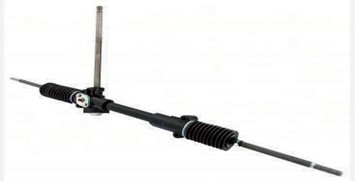
Steering Rack V8
A solid spoke steering wheel was fitted on all MGB GT V8 production cars with the horn operation found in the wheel centre.
MGB GT V8 Interior Trim
Very little changed in the interior with headrests becoming a standard fit along with inertia reel seat belts on the GT V8 models but were still extra on the standard MGB. The trim colours varied and a few early cars from 1973 were fitted with the Ochre trim and Navy trim colour and then 1974 – 1976 they were either black or in autumn leaf.
Body Colours For The GT V8
Many colour options were available for the body and a full list can be found below of the colour used and the number of cars painted in that shade.
| Body colours for the GT V8 | |||
|
Name |
Colour
Code |
Number
Built |
Years
Produced |
| Glacier white | BLVC59 | 513 | 1973/1976 |
| Damask Red | BLVC99 | 472 | 1973/1976 |
| Citron | BLVC73 | 267 | 1973/1974 |
| Teal Blue | BLVC18 | 244 | 1973/1974 |
| Harvest Gold | BLVC19 | 183 | 1973/1974 |
| Bracken | BLVC93 | 154 | 1973/1976 |
| Flamenco
Red |
BLVC133 |
147 |
1975/1976 |
| Blaze | BLVC16 | 147 | 1973/1974 |
| Aconite | BLVC95 | 98 | 1974/1975 |
| Tundra | BLVC94 | 92 | 1974/1976 |
| Tahiti Blue | BLVC65 | 90 | 1975/1976 |
| Black | BK1 | 79 | 1974/1976 |
| Bronze
Yellow |
BLVC15 |
26 |
1973 only |
| Chartreuse | BLVC167 | 19 | 1975/1976 |
| Brooklands
Green |
BLVC169 |
17 |
1974/1976 |
| Mirage | BLVC11 | 17 | 1974 only |
| Green
Mallard |
BLVC22 |
15 |
1973/1974 |
| Sandglow | BLVC63 | 8 | 1975/1976 |
| Black Tulip | BLVC25 | 5 | 1973 only |
| Police White | BLVC1024 | 2 | 1973/1974 |
| Lime flower | BLVC20 | 2 | 1973 only |
| Flame Red | BLVC61 | 1 | 1973 only |
| Ermine
White |
BLVC243 |
1 |
1975/1976 |
| BRG | BLVC25 | 1 | 1975 only |
(Note the number of cars produced above includes pre-production models so actual numbers sold do not correspond to the above)
MGB GT V8 Brakes
It is always a good decision to improve the brakes on any car that is tuned to go faster than originally designed and thankfully the brakes were improved on the GT V8. The front brake system was fitted with larger brake calipers which helped bring the car to a stop along with uprated brake discs this was a standard fit throughout with no alterations throughout the production. A remote brake servo unit became standard on the V8 model to help with the pedal feel and this was soon rolled out on all MGB whether an 1800cc or 3500cc version.
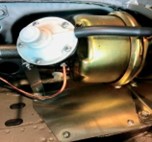
MGB servo unit fitted to the V8.
MGB GT V8 Rear Axle
To help keep the fuel consumption to a reasonable level the V8 was fitted with the MGC’s 3.07:1 differential, this aided long-distance cruising, and all V8 cars fitted with the overdrive gearbox made covering longer distances more pleasurable. No changes were made to the rear axle although the material used was of a heavier grade for the V8 cars over the standard MGB prop shaft.
The V8 Engine
The V8 engine itself is much lighter than the 4- cylinder engine and is stated to be 40lb lighter than the 1800cc option with the block made from aluminium and the cylinder heads made from die- cast aluminium with iron valve guides and valve seats. The actual design of the engine was fairly standard with a five main bearing crankshaft and a central mounted camshaft driven by a chain. Hydraulic tappets were fitted and conventional pushrods and rockers worked the overhead valves and these were set in line in the cylinder heads with exhaust ports found on the outside of the ‘V’ and the inlet ports on the inside.
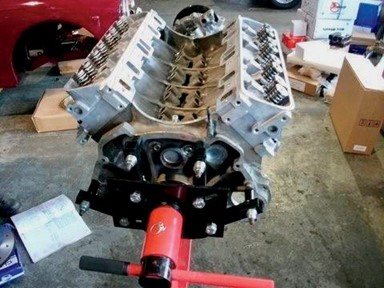
V8 engine block in the process of being built
The factory V8 cars had an 88.9mm bore with a 71.1mm stroke with an engine capacity of 3528cc. Modifications had to be made to enable the engine to fit in the MGB engine bay to avoid any bonnet bulges or alterations and the inlet manifold was made so the carburettors could be fitted at the rear of the engine very close to the heater box, this gave enough clearance for the bonnet to close. The exhaust manifolds were manufactured to fit closely to the block to allow them to mate to the downpipes and then run under the car but this method did generate a lot of heat inside the engine compartment but worked adequately.
Not much really changed in the engine compartment through the MGB GT V8 production, many parts were lifted from the standard MGB like the pedal box and heater system but the V8 engine used a remote oil filter which was situated on the radiator support panel on the left-hand side with the pipes running off that went to the oil cooler that fitted on the front panel and was moved on the rubber bumper cars to below the front panel with the pipework altered to accommodate the change of position.

MGB V8 engine awaiting clutch but almost ready to connect to its Gearbox.
Fuel System
The V8 engine used a pair of HIF6 SU carburettors that were fitted to the rear of the engine compartment and a very similar design to the 1.8 MGB carburettors but with a choke diameter of 1 1/3 in. An air box was designed to fit across both the carburettors but this was very shallow, as it had to fit in front of the heater box and the air filters protruding forward over the rocker cover. The filters are teardrop-shaped, installed with a paper element, and finished in silver with the Unipart label attached to each filter.
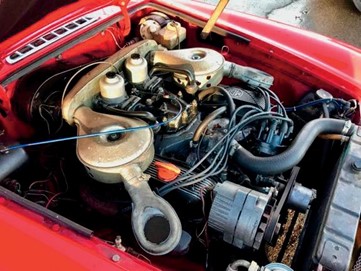
Original Factory V8 air filters
The SU electric fuel pump was a standard item found on all MGB, MGB V8, and MGC cars. Like many components for the V8 derivative, there was only one choice, and the same exhaust system was fitted to all models with the exhaust manifolds on either side of the engine connecting to downpipes which then joined behind the engine making one pipe with two silencers, the rear tailpipe was altered on the rubber bumper version but that was the only item worthy of mention.
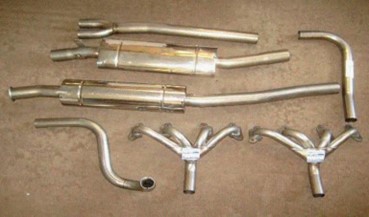
V8 Exhaust system
MGB GT V8 Cooling System
Things did progress with the cooling system and improvements were made to help keep things cool with the big engine, the radiator was moved further forward towards the front of the car. This allowed for extra room in the engine bay for the engine to fit along with a pair of twin cooling fans to be slotted between the radiator and the front panel.
The fans were thermostatically controlled and set to kick in at 90*C. The design of the front grille also helped by allowing airflow to pass through more easily again helping to keep the temperature down.
The cooling system was semi-sealed and came with a separate expansion tank that fitted on the left inner wing. This same system was rolled out on all MGBs from 1977 as the engine bay alterations remained for the V8 fitment but also allowed for the 1800c engine to slot in.

CCHL V8 cooling system

MGB GT V8 Ignition System
A Lucas 35D8 distributor was installed on the GT V8 along with a Lucas ballast coil, which was mounted on the radiator surround. The firing order was 1-8-4-3-6-5-7-2 with all odd numbers on the left-hand cylinders and even numbers on the right- hand side cylinders.
MGB GT V8 Gearbox
The gearbox on the V8 car was modified as the casing was altered to allow a bigger 9 1/2 inch clutch and the clutch master cylinder was also bigger than fitted to the four-cylinder model and a different speedometer drive was used on the V8 gearbox but no other major changes were noted throughout the production.
MGB GT V8 Gearbox ratios
|
|
Gear Ratio |
Overall ratio |
|
First gear |
3.138:1 |
9.637:1 |
|
Second gear |
1.974:1 |
6.062:1 |
|
Third gear |
1.259:1 |
3.866:1 |
|
Fourth gear |
1.00:1 |
3.071:1 |
|
Overdrive |
0.82:1 |
2.518:1 |
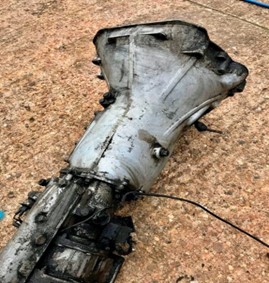
MGB GT V8 Badging
The badges on the V8 were strategically placed with a V8 badge fitted to the left side of the tailgate opposite the MGB logo, another placed on the front grille, and finally, one fitted to the near side (passenger side on RHD cars) front wing just next to the BL badge but not on the opposite side wing. These were fairly discreet badges and just showed enough that anyone taking an interest in the car would be aware it was not your average MGB GT.
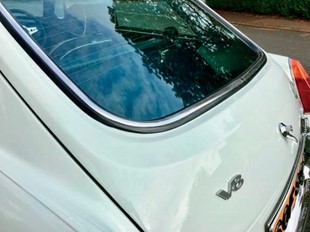
MGB GT V8 production numbers
| Date | Number | Notes |
| December 1972 | 101 | Pre-production, three cars built in
1972 |
| January 1973 | 103 | First pre-
production car built during 1973 |
| April 1973 | 124 | Start of total
production |
| August 1973 | 604 | Start of 1974
model |
| January 1974 | 1173 | First car built
1974 |
| September 1974 | 1956 | Last 1974 model
chrome bumper car |
| September
1974 |
2101 | First 1975 rubber
bumper car |
| January 1975 | 2167 | First car built in
1975 |
| August 1975 | 2632 | Last 1975 model |
| October 1975 | 2701 | First 1976 model |
| January 1976 | 2721 | First car built in
1976 |
| June 1976 | 2901 | End of series
production |
| July 1976 | 2903 | End of
production |
The total number of cars produced was 2591 with 1856 chrome bumpers and the remainder 735 rubber bumpers.
The wheels on the GT V8 were special to this model and supplied by Dunlop and the middle section a cast alloy wheel but with the outer rim chrome plated steel and were the same four stud pattern as the rest of the MGB range but the wheel nuts are larger in size and special to this style of wheel.
The rim size was 5Jx14 and all had a Centre cap with the MG logo to finish them off, this particular style of wheel was also used on the Jubilee model in 1975 but painted black and gold with a gold MG badge. 175HR-14 radial ply tyres were used for the V8 cars. This was the only style of wheel offered on the MGB GT V8 cars that was one of the more distinctive signs that the V8 was a little bit different from the standard car.
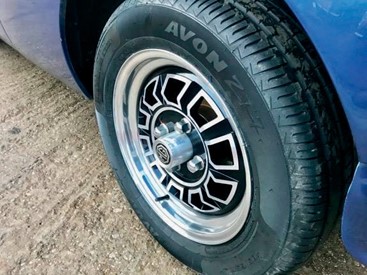
MGB V8 side view with V8 wheels fitted
| MGB GT V8 specification details at a glance | |
| Production years | 1973-1976 |
| Body type |
GT version only from factory |
| Engine | 3528cc V8 |
| Bore | 88.9mm |
| Stroke | 71.1mm |
| Compression ratio | 8.25:1 |
| Engine block | Aluminium block |
| Fuel | Twin SU Carbs |
| Fuel tank | 12 gallons |
| Max power | 137bhp @ 5000rpm |
| Maximum torque | 193lb ft @ 2900rpm |
| Power-to-weight ratio | 128.4 bhp/ton |
| Maximum speed | 125mph |
| 0-60mph | 8.5 seconds |
| Fuel consumption | 22mpg |
| Gearbox |
4-speed manual with overdrive |
| Brakes | discs front and drums rear |
| Steering | rack and pinion |
| Wheels |
Composite alloy centres/steel rims 5J x 14 |
| Tyres | 175HR 14 radial tyres |
| Unladen weight | 2390Ib |
